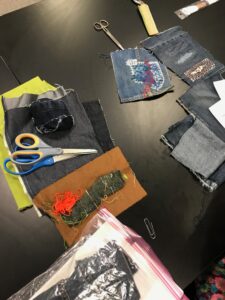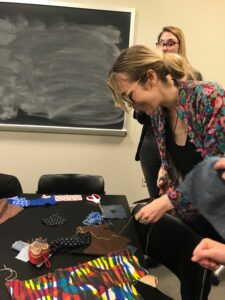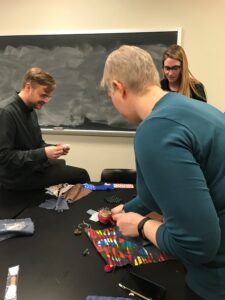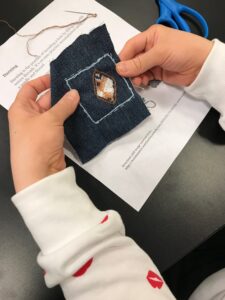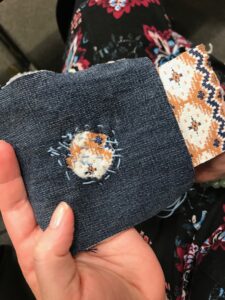Welcome to CUNY Academic Commons. This is your first post. Edit or delete it, then start blogging!
The Family Heritage
It was a hot July evening, during the craziness of my wedding preparations 6 years ago, when my grandmother called me to her room to discuss something important. She had her old wooden trunk open and a bunch of jewelry boxes sitting on her bed. This was one of those activities that she does only did when she was feeling down, so as soon as I walked in I was concerned. The bed was loaded with open boxes of fine jewelry, she was sorting and deciding which pieces needed a good cleaning before the wedding. Most of it was decades old, and I was drawn to this one particular piece that I had never before seen the likes of.
Being a fashion design student, I had been familiar with vintage clothing and shoes of different cultures. But Pakistani vintage jewelry? It was something that I had always overlooked. Of course, I knew it was there but during those years, I would much rather purchase an impressive vintage dress that would make a huge visual impact. Jewelry always seemed subtle in comparison.
 This particular piece of my grandmother’s collection that I was drawn to, was a unique piece indeed. The piece belonged to my grandmother’s grandmother. Which was passed down to her. It might be older than that we don’t know that for sure. This would mean that this earring set was at least 150-year-old. It was pure 24 carat gold with 9 precious stones (it is called a nauratan- 9 jewels) encrusted in the leafy pattern. The stones included pearls, rubies, sapphires, turquoise, emeralds, zircon, hessonite, diamond and red coral.
This particular piece of my grandmother’s collection that I was drawn to, was a unique piece indeed. The piece belonged to my grandmother’s grandmother. Which was passed down to her. It might be older than that we don’t know that for sure. This would mean that this earring set was at least 150-year-old. It was pure 24 carat gold with 9 precious stones (it is called a nauratan- 9 jewels) encrusted in the leafy pattern. The stones included pearls, rubies, sapphires, turquoise, emeralds, zircon, hessonite, diamond and red coral.
The earring was with some intricate detailing and tiny pearl tassels. The flowers were mounted on gold coloured leafy design. The design was very vintage looking gold. The earring was about 3.5 to 4 inches, with a clasp back.
As I held that earring in my hand for the very first time, I was in awe. It was then my grandmother told me how this particular earring set had been passed down generation to generation. My grandmother had acquired this from her mother on her wedding and had later passed it on to my mother for hers. My mother had polished it and given it back to my grandmother for safe keeping. She told me that she wanted to pass this piece of our family heritage down to me, so I could continue the tradition. I was so excited. It became my treasured piece and was so different from anything else I’ve had ever worn. I wore it so often during the first few months of my marriage. When I was moving to the States, I had handed the earring back to my mother for safe keeping.
That earring is a proof of quality and craftsmanship from the late 1800’s (if I’m not wrong). And I’m blessed to be the one it was passed on to by my grandmother. I might pass it on to my baby sister on her wedding someday, as I want her to cherish our heritage too!
care + repair: everything you own is handmade by c. zimmerman
A bevy of samples, bits of clothes, scissors and needles covered the desk at the front of the classroom and Professor and crafter Kat Roberts began to speak. Discussing the history of clothing production she ruminated on how fast fashion has alienated people from the care and keeping of clothes. This process happens in a multitude of ways; production wise, fast fashion clothing is not manufactured to last, individually many people have lost the skills associated with tending to worn clothes and culturally, the value of clothing is often constructed around trendiness over longevity or craftsmanship. Roberts discussed the semantic distinction between handmade and mass-produced; while the former brings to mind artisan production, the latter fails to acknowledge the many hands and invisible labor that goes into making all clothing. To contextualize the conversation of our workshop, Roberts mentioned that in actuality, all clothing is handmade. While many of us don’t have the time to make our clothes, taking a moment, in this case a few hours, to mend to our worn items provides a pause to reflect on these labors and our relationship to them as Fashion Scholars participating in the Fabric of Cultures project.
After a brief demo of various stitching techniques, Roberts showed various samples and outlined different techniques for repair, from machine sewing to hand sewing, from patching to sashiko mending. These techniques and their requisite aesthetic can be modified to fit the maker’s desire; low contrast stitching and matching patches for a subtle look, or high contrast and decorative stitching for a more bold one. One of the participants, who works at a high end Italian fashion house, remarked that the swatches reminded him of some of the company’s work, and we briefly discussed high end fashion’s obsession with appropriating the ‘worn look’.
With two participants admitting to limited sewing experience, and another mentioning how “terrible” they were at it, Robert’s simple instruction and handouts provided everyone with the confidence to start stitching. We rummaged through a stack of various denim and printed fabrics (of note was a particular green velvet patterned with stars), threaded our needles and began to make small patches. With our hands busy, the conversation flowed freely, from our current research topics, to the rise of streetwear in Couture, to the performance of gender through dress vis a vis Foucault and Butler. Many people noted how the time simply flew by, and our occupation with small bits of cloth enabled many of us to get to know one another for the first time.
This workshop coincided with Fashion Revolution Week, a week of action to commemorate the Rana Plaza collapse as a part of a larger project to support more transparency in the Fashion Industry. In one their toolkits (downloadable free online), #Haulternative, the Fashion Revolution team suggests getting crafty, and taking the time to repair or alter a beloved item of clothing as a possible action against the endless waste of the Fashion Production system. Our workshop, and the relaxed crafting and conversating certainly felt fitting, and allowed the participants to experience alternatives to traditional academic space, a welcome reprieve and a potent combination for rich conversation.
“Treat your friends like the good clothes they are” Joan Crawford
More resources and info at:
“The History of Change is Filled with Clothes”
Title: “The History of Change is Filled with Clothes”
Publication: https://www.businessoffashion.com/
“A woman must not accept; she must challenge. She must not be awed by that which has been built up around her; she must reverence that woman in her which struggles for expression.” – Margaret Sanger
Equality is more than the right to vote, and last year’s protests on the red carpet were the start of a new revolution. From the Suffragettes to Nasty Woman, over the centuries, people have banded together to demand change and show solidarity through clothing. Whether it is a movement, protest, initiative or collaboration, clothing can help tell a story. In this case, shine a light on harassment, abuse and oppressive behavior in the workplace.
Women are fed up! The criminal acts and sadly, well known sexual misconduct of Harvey Weinstein, Bill Cosby, Matt Lauer, Louis CK, Al Franken, and countless others prompted a call for justice. Several A-list actresses leveraged their celebrity and raised their collective “voice” to demand change through their Time’s Up initiative, sending a powerful message that abuse of power would no longer be tolerated. Following “the honorable tradition set over a century ago by the suffragettes, who harnessed fashion, and the meaning of color as a method of communication,” Golden Globes attendees wore black as a message of hope and solidarity to victims. (Mower, 2018) In this instance, they chose the color black to symbolize unity and serve as a color of collaboration rather than one of mourning.
It’s interesting, an article of clothing on the surface seems innocuous but paired with a message, it is seen as hope, unity and cause for change. Choosing an easily accessible color brought the protest to the mainstream and it became a movement that extended beyond the awards shows. Whether individuals marched, watched from home or followed along on social media, they could join the cause. And they did! Women around the world donned black as a symbol of solidarity and a call for action. Seeing that they were not alone, individuals – both men and women – were inspired to come forward.
Protest clothing shows numbers and has proven successful in becoming a symbol of strength and resistance. Most important, it introduces a new perspective which has the power to unify and energize the masses. When Amelia Bloomer challenged the ideas of what a woman should be and wore pants, people “worried that the lack of hoop skirts would lead to the usurpation of the rights of man”. Pants then became a symbol of the women’s rights movement. The suffragette colors of purple, green and white were worn by women to identify themselves as supporters of the cause outside of rallies. (Komar, 2018) More than visually identifying supporters, protest clothing sparks conversations while also allowing people to support it even if they don’t want to talk about it.
The protests were a reminder of the many strong women before us who had the courage to stand up visually and fight for justice. Suffrage leaders, Susan B. Anthony, Elizabeth Cady Stanton and Lucretia Mott would have embraced Time’s Up show of strength and resistance. We are now in the second phase of the suffrage movement. Hillary Clinton said it best with her statement that “the rights of women and girls is the unfinished business of the 21st Century.” In this instance, wearing black helped spread a message of hope and showed resistance. It worked. The show of support gave women courage to come forward and tell their stories. “Shining a light on harassment has forged a community where women feel authorized to raise their voices in ways they never have before,” said Rachel Simmons a leading expert on girls’ empowerment. (Wallace, 2018)
Whether a person agrees with the movement or not, it is important for people to see. Most important is that conversations are occurring. The message was received and ordinary people ran with it. Sanyin Siang, a coach and adviser to chief executive officers recently said that “one of the wonderful upshots of the sexual harassment allegations is a greater sense of psychological security in the workplace.” (Wallace, 2018)
The movement and protests have also highlighted the work that still needs to be done. The unifying factor of the protest served as a wake-up call to our leaders in government, industry and business that “time’s up for pay inequality, time’s up for discrimination, time’s up for harassment of any kind, and time’s up for the abuse of power.” (Monae, 2018)
Fashion Revolution; Zara, Fast-fashion global brand of Inditex
Zara has become one of the leading fast-fashion global brand in recent years. The brand’s fashion-forward designs, quick turnaround products and affordable prices are changing the fashion industry. On Zara’s official website, indicates that Zara is one of the largest international fashion companies that belongs to Inditex, one of the largest distribution groups. Inditex (Industria de Diseno Textil), a Spanish corporation founded by Amanico Ortega in 1975, owns eight brands which include Zara, Zara Home, Massimo Dutti, Pull&Bear, Bershka, Oysho, Stradivarious and Uterque. Inditex present in 94 markets, 45 of them online, in all five continents with more than 7,000 stores and Zara has the most stores, currently 2,236 worldwide. The founder, Ortega has been on the Forbes list as one of the world’s richest person and resigned as chairman in 2011. Pablo Isla is current CEO of Inditex.
What is fast-fashion? In 1990, Jonathan Van Meter wrote a prescient article for the Vogue, “Fast-Fashion: Americans Want Clothing that is Quick and Easy”. Now fast fashion term evolved to design that reflects fashion runway shows and recent trends in affordable prices. Zara is known to be the pioneer of fast-fashion and has enormous number of stores globally and their merchandise move incredibly quickly, and the turnaround speed is so fast that Zara stores’ entire inventory changes within 11 days. How is this possible? In 2017, Zara manage up to twenty clothing collections and this is ten times more than the traditional biannual cycle of high-end fashion. Now more than half of the high-end companies, such as Prada and Louis Vuitton, are making four to six collections instead of two each year because of Zara.
Trendy fashion products are accessible and affordable by fast fashion brands, there are few other fast fashion brands trending, such as H&M, Topshop and Mango and I argue that Zara dismissed the image of “cheapness” from fast fashion brands. Zara achieved brand recognition through runway-inspired products, upscale stores, and low discounting improved their name value. What type of marketing or branding discourse did Zara provide to present their products affordable and yet fashionable? How did Zara establish brand recognition and name value globally? I reviewed article on “How Zara Grew Into the World’s Largest Fashion Retailer,” The New York Times Magazine, by Suzy Hansen (2012). She notes Inditex imitates the latest fashion and speed their cheaper versions into stores. Zara sells trendy and decently made inexpensive products in beautiful, high-end looking stores. Inditex is ambitious to find valuable real estate for their stores and prefers iconic buildings, in 2011, they paid $324 million to buy a space at 666 Fifth Avenue in New York, a building best known for being the most expensive ever sold in Manhattan.However, Zara cannot avoid the major problems that fashion companies’ encounter, particularly poor or even deadly factory conditions along with factory workers’ low wage. Most recently in 2017, Zara factory workers in Turkey were unpaid for three months. They placed notes inside clothes which customers purchased in Istanbul and the notes indicated that, Bravo Tekstil clothing factory in Istanbul, which is one of Zara’s factory, owed the workers three month pay and severance allowances. The factory closed overnight, and the factory owner and management fled with funds without any further notice. This caused an outrage from the media and in result, Inidex paid the factory workers. Through global sourcing of clothing manufactured in developed countries, the fashion industry has been widely criticized of poor working condition even death among workers.
One of the notorious deadly building collapse recently involved with the fashion industry was in 2009 at the Rana Plaza in Bangladeshi. The building collapsed and at least 142 people died, and more than 1,000 workers were injured. These factories were making clothing for European and American brands, which include Spanish brand Mango and low-cost British brand Primark. The price competition among low-cost suppliers resulted in difficult or dangerous working conditions, commonly known as “sweatshops”. This tragic accident brought international awareness to provide safe environment and healthy working conditions for factory workers. As a designer myself and working in the fashion industry, it is heartbreaking to hear such tragic news and urge the fashion industry to improve labor and factory conditions, which include paying workers properly and consider their well-being as well.
Zara achieved brand recognition and name value through its success and I argue that the brand dismissed the image of “cheapness” of fast-fashion. However, through researching the global fashion brand, I realized that Zara cannot avoid the notorious problems related to fast-fashion brands and urge Zara to become a moral role-model among the fast-fashion retailers.
Op-Ed: Fashion semiotics and politics in the press tour for Black Panther
In the past several weeks, I have been following closely the press tour for Marvel’s smash hit, Black Panther. A highly anticipated adaptation of the comic books, Black Panther joyously takes its viewers on an astonishingly creative and moving journey of the protagonist, King T’Challa. The sovereign of the fictional nation of Wakanda, a hidden African country both rich and advanced, T’Challa rules a nation of people who have never been colonized. In terms of both politics and fashion, the lack of colonization is a very important theme. The costumes Ruth E. Carter created for the movie walk in a distinctly Afro-futuristic path in which traditional African fashions meet technological advancement with a colorful, sleek result. The importance of African influences, therefore, traversed beyond the movie and into its promotional strategy. In this post, I would like to discuss the extraordinary meeting between Hollywood sartorial traditions, the culture of superhero franchises, and race politics in the press tour for Black Panther.
In the past decade or so, promotion for Hollywood movies with large budgets (mostly superhero movies) has been characterized in three ways: recognition, location, and fashion. Firstly, the recognition comes with the presence of the leading actors (and sometimes the director, if they’re well known) in both press junkets, premieres, and additional promotions (TV ads, online content, product endorsements). Secondly, the locations of the promotion vary in a rapid pace: the actors are often taken on a whirlwind tour in which they promote the movie in a different city every other day or so for two weeks at the most. They often fly to different continents, adjust to different cultures, and speak different languages (if they are able). This is done in order to localize the promotion of the movie for audiences who are not necessarily attuned to American entertainment. Thirdly, the fashion of the promotional tours follows a strict code: upgraded casualwear for press calls, bespoke couture for premiers. Unsurprisingly, the appearance of actresses is scrutinized much more closely than actors in those occasions. Equally unsurprising is the studio budgeting of stylists and hair/make-up artists specifically for this purpose.
The press tour for Black Panther has been, in many ways, a standard big budget movie press tour, with one notable exception: the importance it placed on fashion, and the close collaboration Marvel Studios had with the fashion world. Far from the traditional gowns and tuxedos, the brief for the Los Angeles world premiere of the movie seemed to be “royal attire.” There were no tiaras or ermine capes in sight; instead, many of the black celebrities in attendance dressed to emulate either their native lands, or African heritage. Several others, including much of the leading cast, chose to wear clothes by Western fashion houses which either reference African cultural influences, or were paired with African-inspired accessories. Lupita Nyong’o, for instance, wore a custom Atelier Versace dress which evoked militaristic themes together with traditional eveningwear, paired with traditional Yoruba hairstyle. Chadwick Boseman wore an Emporio Armani fall 2018 ensemble which paired a flowery heavy-silk double-breasted jacket with pleated pants, pairing gold and black for royalty, and flowers for an untraditional take on the tuxedo jacket.
The meeting between Afro-futurism and Western fashion continued on other occasions as well, during which the leading cast wore ensembles by Givenchy, Calvin Klein, and Balmain, among others. All ensembles had either an African-inspired motif or were paired with African-inspired accessories and/or hairstyles. The meeting between the promotion for Black Panther and the fashion world continued past the premieres into a collaboration between Marvel Studios and New York Fashion Week. In a February 12th showcase named “Welcome to Wakanda,” ten fashion designers or houses exhibited custom looks designed with Black Panther in mind. The leading cast once again assembled, wearing interesting interpretations of the costumes worn by their characters. Notably, the color story of their clothes was earth tones. Chadwick Boseman even wore a black hoodie, perhaps as a nod to his character’s black superhero suit, perhaps as a salute to the Black Lives Matter movement.
The politicization of the Black Panther press tour, particularly when it comes to combining the semiotics of black power, fashion innovation, and Hollywood image management has been fascinating to observe. This movie, with its all-black leading cast, championing not only black excellence but also African traditions, has already made an indelible cultural impact. It is important to note that major fashion houses have not been known to offer their wares (especially couture runway looks and custom creations) to major black actors perhaps until this decade. That Chadwick Boseman, Danai Gurira, Michael B. Jordan, and Lupita Nyong’o have all repeatedly worn couture, sometimes with them specifically in mind, is nothing less than groundbreaking. On a last note, the immediate impact of Black Panther’s sartorial flare has been notable even when it comes to its audience: many black audience members chose to dress up, in order to emulate their cultures and traditions for the opening weekend of the film, both in the United States and in Africa. This is virtually unheard of, even in superhero culture, where audience members often dress to emulate their favorite heroes for screenings. The long-term implications of Black Panther as a cultural marker are still unknown, but they are surely substantial, as can already be seen.
- Lupita Nyong’o in Atelier Versace and a traditional Yoruba hairstyle
- Chadwick Boseman in Emporio Armani Spring 2018 ensemble for the Black Panther world premiere
- Chadwick Boseman in Fear of God
- Chadwick Boseman in Givenchy Couture
- Lupita Nyong’o in Atelier Versace, Winston Duke in Etro, and Danai Gurira in Gabriela Hearst at Oscars 2018
- Daniel Kaluuya in a kanzu
- Michael B. Jordan in Calvin Klein
- Chadwick Boseman in Givenchy
- Lupita Nyong’o in Balmain
- Lupita Nyong’o in Kevin Mayes and Danai Gurira in The Row
Fashion Revolution Week: the Sustainable Natural Revolution of Hemp
During last decade, the concept of sustainability has become progressively integrated to the every aspect of fashion. How can we define sustainability? Why is the relationship of fashion and sustainability important? These are important questions that are frequently discussed in the world of fashion. Under this perspective, the use of eco-friendly fibers plays a key role in finding viable options to reduce the environmental transgressions that occurs during the production of textiles.
In order to understand the importance of the relationship of fashion and sustainability we must begin by exploring the meaning of sustainability. The World Commission on Environment and Development defines sustainability as “a process of change in which the exploitation of resources, the direction of investments, the orientation of technological development and institutional change are all in harmony and enhance both current and future potential to meet human needs and aspirations.” Indeed, sustainability is complex concept as it involves an analysis of how we use our natural resources while maintaining an equilibrium of optimal and efficient level of productivity and technological development. This has a tremendous impact on the fashion industry because the production of fibers, fabrics, and garments contributes largely to the world’s carbon footprint. In fact, as Mike Schofield and Alan Williams, authors of the book OCR GCSE (9-1) Business, mention, fashion industry is considered the second biggest polluter in the world just behind of the fuel industry.
Thus, to change this situation and eliminate the environmental transgressions that are involved in the production of textiles and clothing, the fashion industry has implemented a series of measures such as the reduction of the use of dyes, chemicals, fuels and water consumption. Moreover, eco-friendly fibers have starting to replace cotton, which requires a huge amount of pesticides, fertilizers, and water. For instance, the Wild World Fund reports that 20,000 liters of water are needed to produce 1 kilogram of cotton fibers, which are only enough to manufacture one T-shirt and a pair of denim pants.
Therefore, the use of hemp for the production of textile fibers represents an attempt of the fashion industry to minimize the pollution produced by the fashion industry. Hemp has been grown since ancient times as renewable source of raw materials such as textiles. Although hemp belongs to the same species of Cannabis Sativa as marijuana, it is different from it since the amount of tetrahydrocannabinol (THC) it contains is extremely low. Therefore, it has no psychoactive effects. However, the cultivation of hemp in the United States is regulated by the Marijuana Tax Act, and until very recently hemp crops were illegal. Annie Gullingsrud in her book Fashion Fibers: Designing for Sustainability describes hemp as a rapidly renewable fiber that can grow very fast, reaching 4 meters in only three months. In addition, it requires no herbicides or special irrigation systems, which makes hemp environmentally friendly. Hemp fibers are extracted from the stalk using a mechanical process. What is most important is that natural moisture of dew is used to extract the fibers from the plant, and the remains of the stalk and leaves of it can be left on the field after the harvest. As a result, this eliminates the need of fertilizers rich in nitrogen as well as the negative impact of nitrates on the nitrogen cycle of ecosystems. On the other hand, hemp can store carbon dioxide, and it requires about half of the amount of water that is used in cotton crops. In addition, hemp is a biodegradable natural fiber, meaning that it can be decomposed by bacteria or other living organisms, reducing the pollution and waste in the environment, which is generated during the manipulation of this fiber in the clothing mass production.
There are many companies like Enviro Textiles located in Glenwood Springs, Colorado that sell eco-friendly and organic textiles, especially a variety of hemp fibers. According to the Enviro Textiles’ website, they specialized on canvas, twill, muslin, weaves, knits, fleece, silk, and upholstery fabrics made of hemp. They also have sponsored famous designers like Donatella Versace, Behnaz Sarafour, Ralph Lauren, Donna Karan, Isabel Toledo, and Calvin Klein, and these designers have included hemp fabrics in their collections. Other companies such as Nomads offer a wide variety of casual clothing made of hemp as a primary fiber source, and their target consumers are young women that care for the environment and like to look fashionable and trendy.
Undoubtedly, in this time where people are getting more conscious about the implementation of new resources to promote sustainability in the fashion field, the use of natural sustainable fibers, such as hemp, constitutes an eco-friendly alternative to create a more responsible fashion industry.

Source: Culture Magazine

Source: Jungmaven
Word Cited
Gullingsrud Annie. Fashion Fibers: Designing for Sustainability. Fairchild Books: February 9, 2017
Schofield Mark and Williams Alan. OCR GCSE (9-1) Business. Hodder Education; 3rd revised edition: June 30, 2017
http://wwf.panda.org/about_our_earth/about_freshwater/freshwater_problems/thirsty_crops/cotton/
http://www.un-documents.net/ocf-02.htm
Liberal feminism: a path for emancipation or perpetuation of inequality?
Eisenstein Hester in her article “The Sweatshop Feminists” reflects on how feminism ideologies have been manipulated to support the hegemony of neoliberal capitalism, a subject feminism was meant to challenge. Eisenstein articulates several issues on the general trends of feminist movements with an inclination towards institutionalization and its preconception of identity, culture, and difference. The author supports other feminist concerns about the fall of the original collective emancipatory fight for women rights to employment and independence.
Liberal feminism has played a critical role in legitimizing corporate capitalist ideas and practices which undermine feminist efforts to defend and safeguard the women’s distinct labor needs and interests. Advocacy for women’s professional development, struggle for full integration into capitalist economies, and the push for gender equity in the workplace was in a way meant to justify the elimination of welfare programs and reduction of worker wages by the neoliberal elites. Neoliberalism penetrated the Global South and influenced government policies that allowed Export-Processing Zones (EPZs) to operate as non-governmental organizations where worker welfare movements are prohibited. This development worked to destabilize the radical feminist reforms and struggles as women workers suffered beatings, unpaid overtime, abductions, arbitrary dismissals, intimidation with firearms, verbal abuse, and interrogations. Further, there is the contention that individualization of women has been ingrained in extremely sexualized and consumerist ways.
Eisenstein’s approach is centered on the social-economic sphere that is immensely characterized by gender oppression and the role of wage labor in women’s lives in the 21st century. In this view, I find the author insensitive to the economic causal dynamics, instead, the author bases her argument on culture and identity as the source of distraction to progressive feminism. Well, she has a credible argument that should be addressed in efforts to reinventing feminism and forging an optimistic future laudable move
While I appreciate and support the author’s concerns on how neoliberals have capitalized on women empowerment to achieve their capitalist interests and undermine feminist politics, I think her work should also be critically interrogated on the basis that Eisenstein’s interpretation of co-optation drives some sense that waters down the particular feminist efforts. In my view, the author’s approach sounds more of an anti-globalization activism that draws generalization and unwarranted pessimism. In addition to derailing and driving feminist efforts towards the negative direction, it cuts the hope for a future rejuvenation of feminism.
In my opinion, the progressive feminist politics propagated by Eisenstein are embedded with some flaws. Her argument relies on socialist feminism in reviving and advancing feminism politics. She neglects the internal conflicts and centers her focus on revaluing of care work as a solution to attaining actual feminism goals. Also, she seems to be disciplining feminism from a position of authority that sanctifies past socialist feminists and belittles other liberal feminists. Adopting her position may threaten to cause further fractures among feminists and undermine the hard-won feminist alliances. Moreover, Eisenstein provides the trajectory that progressive political practice should take such as mass awareness and mobilization campaigns, popular education, unionization, cooperatives and coalition building. However, in a neoliberal era, she makes an assumption that such practices will automatically occur following the revival of social feminism as an agent for progressive politics. Therefore, her approach appears biased towards Marxist practices over feminist practices.
Overall, Eisenstein’s assertion on cultural practices that promotes identity and recognition through institutionalized practices on gender mainstreaming and service provision is admissible as feminism progressive strategy. She highlights the need for radicalized efforts and activities such as mass mobilization, education, advocacy, and service provision for purposes of keeping governments checked and accountable for individual acts of empowerment. However, my argument emphasizes on the inclusivity and reflexivity of such efforts. I support more concrete and robust feminist activities that resist neoliberalism and create a world where both men and women are fairly and equitably treated with dignity.
“Fashion Revolution” Rana Plaza Tragedy
On April 24th, 2013, one of the worst disasters in fashion history happened, the collapse of Rana Plaza. This building housed five garment factories making clothing for globally recognizable fashion brands.
Before this, you may not have thought about where and how your clothes were made and produced. This tragedy shed light on how hard people work to produce clothing you usually wouldn’t think twice about purchasing.
This tragedy finally awakened people to realize the horrific working conditions in developing and third world nations.
We used to wear our clothes for many years, buying staple pieces with longevity that we would be able to hold onto forever. With the introduction of fast fashion, we now want a new wardrobe every year and we want to pay much less for it. Companies like H&M and Mango need to keep their production costs down so that we can pay low retails, for example, $19.95 for a sweater. Western fashion brands expect their factories to rush new orders to meet the latest clothing trends.
These are low-skill jobs, and the industry relies on a low-wage labor force in order to manufacture their designs at the lowest cost possible. So in order to fulfill these orders quickly, factories often disregard safety and human costs. Workers often work long hours without even restroom or lunch breaks. Workplaces such as Rana Plaza often have poor ventilation, and ignore basic safety measures such as clear fire escapes.
Since I work on the production side of the fashion, I can understand negotiating lower prices on fabric and rushing orders to be in stores on time even though I do not work for a fast fashion brand; we work closely with all our factories. However, this does not mean that our factories do not hide certain conditions from our American counterparts who control the quality of the work conditions overseas. When these factories feel the pressure of meeting deadlines in order to make the money from an order, they can often times cut corners and ignore safe work conditions in order to get the job done, all while keeping up the facade of being a safe and law-abiding factory. This kind of deceitfulness is what can ultimately cause conditions to become worse and worse, eventually leading to tragedies such as the collapse of the Rana Plaza.
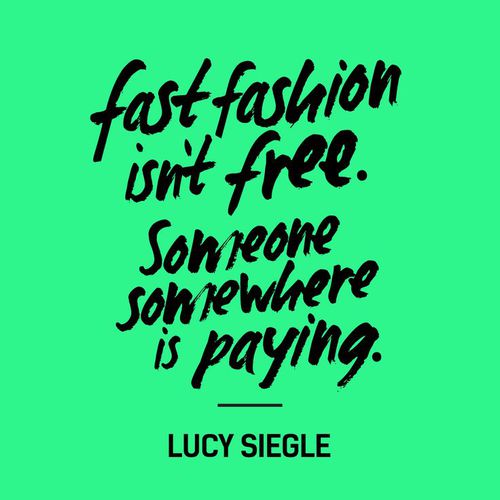
Human rights after Rana Plaza & The Continuous Fight for #Transparency
Walking along the Hudson River, on the very edge of the city of Hoboken, my friend and I were enjoying the night sky after work when she said she missed looking out and seeing the Twin Towers. It’s not that we forget; as a person who was from the city, lives in the city now, or lived when a tragedy happened: that memory doesn’t wash away. There is always a piece of tragedy stuck within you. When reading through the Fashion Revolution website, I am reminded again that fashion production needs transparency when I think of another tragedy: The Rana Plaza building in Dhaka that may have killed an almost 30-billion-dollar industry, but more importantly, the lives of those who were lost is an outrage to this day. From “4 Years After Rana Plaza Tragedy, What’s Changed for Bangladeshi Garment Workers?”, Westman writes:
“But four years later, a report on supply chain transparency released by Human Rights Watch finds only 17 of 72 apparel and footwear companies contacted by a coalition of labor and human rights groups and global unions have agreed to implement a transparency pledge by the end of this year”.1
Why is it that demand for human rights are only sparked out of these tragedies? What takes us, as consumers, and as people, to realize that we cannot afford a tragedy to spark action? After years of remembering the terror, we are still left with a strong fight to demand that our labor rights are protected. It was only last semester that through my own research in New York’s Garment Industry history that I found an article on from 1983 that talked about the rise of sweatshops; From “AFTER YEARS OF DECLINE, SWEATSHOPS ARE BACK”, Serrin states:
“The new sweatshops are in Chinatown, on Roosevelt Avenue in Queens, on Jerome Avenue in the Bronx, in Long Island City, in West New York and Jersey City in New Jersey and in other places – places where men and women, including many illegal immigrants, toil at low wages, for long hours and often in hot, bleak, unsanitary and unsafe conditions”.2
Exactly 20 years later, we had Rana Plaza. We had the same packed floors, heated work environments and no legal repercussions that makes a statement to our world that the problem is not in decline. How many more sweatshops, or illegal garment production environments must collapse before we demand transparency in fashion production, and not just simple hope for it?
Garment industry unions have declined, as well. On the Fashion Revolution page, the Garment Worker Diaries has painted an accurate portrait of the every day lives of the garment workers today in Bangladesh, China, and India3. In Bangladesh, workers are enringing minimum wage at 60 hours a week, compared to China and India; workers still report, from the MFO, that they don’t feel safe in the work environments.3 Again, I am astonished to read that reports I studied from the Progressive Era sound familiar to statements made in late 20th Century about age, gender, and sex discrimination4. With the demanding and illegal work environments, the same disgust grows from harassment in the work place. For example, to put a timeline in prospective, in 1909, before the devastation of the Triangle Shirtwaist Factory occurred, workers from the Triangle Shirtwaist Factory demanded improvements to the 14-hour long job they endured everyday where bathroom breaks occurred on the shop floor. After the disaster in September of 1909 with The Triangle Shirtwaist Factory, the police chief of New York City in 1911, Theodore Bingham, guessed that over 2,000 foreign women were enslaved in brothels after being brought into the United States5. It’s as if we moved backwards, especially fast forwarding to when the Rana Plaza collapse occurred. It makes transparency even more prevalent in 2018 as a call to finally say “we have had enough”.
To follow the trend of the Fashion Revolution, and out of the horror I have had to research, I have sent out my own agenda; using the hashtag #whomademeclothes, I am sick of researching the non-changing statistics and want to really know: who is making the clothing I buy, and sell (working in retail), every single day that could cost the life of someone here in New York, or overseas? So, I have a simple story: I bought shoes for $1.00 at Francesca’s the other day and I tweeted them the answer I want:

Maybe there was a great sale, or I missed something in that moment of exchange at the Francesca’s I shopped at, but I want to know where my shoes are from. It’s small step, but one we should all take. I will post on updates to come on if anyone responds to my tweet, but I won’t give up the fight to try to avoid another article of tragedy to occur. What we need is the action and demand to make sure the literature of the future talks about garment industry illegality and poor work conditions in the past tense, not the present. For now,
Carolyn J Cei
Demand transparency here: http:///fashionrevolution.org/
References
1 4 Years After Rana Plaza Tragedy, What’s Changed for Bangladeshi Garment Workers? Parallels : NPR. https://www.npr.org/sections/parallels/2017/04/30/525858799/4-years-after-rana-plaza-tragedy-whats-changed-for-bangladeshi-garment-workers. Accessed 23 Apr. 2018.
2 “Home.” Fashion Revolution, https://www.fashionrevolution.org/. Accessed 23 Apr. 2018.
3 Bangladesh_Data_Portal. http://workerdiaries.org/gwdiaries/bangladesh/story_html5.html. Accessed 23 Apr. 2018.
4 Serrin, William. “After Years of Decline, Sweatshops Are Back.” The New York Times, 12 Oct. 1983. NYTimes.com, http://www.nytimes.com/1983/10/12/nyregion/after-years-of-decline-sweatshops-are-back.html.
5 Smolak, Smolak, and Alex Smolak. “White Slavery, Whorehouse Riots, Venereal Disease, and Saving Women: Historical Context of Prostitution Interventions and Harm Reduction in New York City during the Progressive Era.” Social Work in Public Health, vol. 28, no. 5, 20130801, pp. 496–508.
Top image credit: https://weheartit.com/Carmen3421
